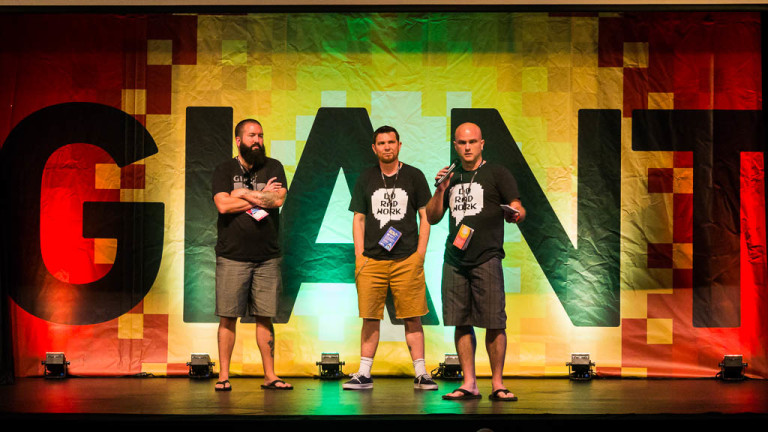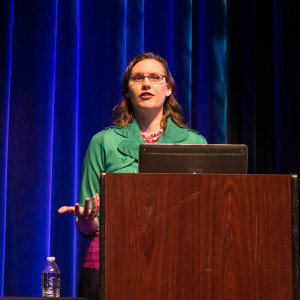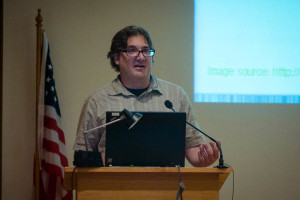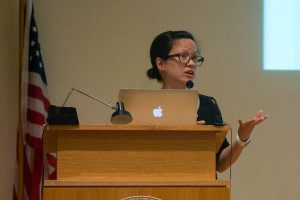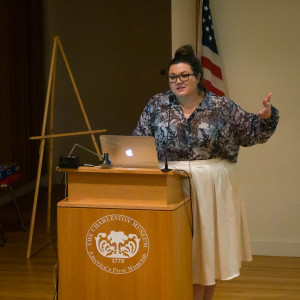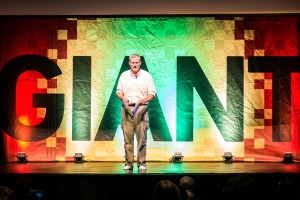Giant Conf is over for another year and I felt energized and inspired to go into work and make mistakes, stop being perfect, fail often and ask lots of questions. Over the three days I saw 20 different speakers and had fun trying to keep up these notes. Revisiting them here helped solidify some of the concepts in my head. I hope they become useful to you somehow.
Thanks to everyone at Giant Conf for making this another great learning experience!
Learn it forward – Leslie Jensen-Inman
The general gist: Cultivate a culture of learning. Take time everyday to share what you’ve learned and how you will do things differently in the future.
- Comprise teams with senior folks with more experience
- These are the people that others can learn from
- Help junior designers learn from their mistakes
- 4 stages of learning:
- Unconscious incompetence – You don’t know what you’re doing. You don’t know what you’re doing wrong.
- Conscious incompetence – You know that you’re doing things wrong.
- Conscious competence – You know how to do things right, but it takes conscious effort.
- Unconscious competence – You do things well in your natural flow.
Center Centre
- The Center Centre wants to be a learning organization, not just an organization for learning like most schools.
- They want to build a culture of life-long learners.
- They share mistakes and failures everyday in a daily standup meeting.
- They ask the same 5 questions in the meeting everyday:
- What did you get done?
- What are your goals for the next standup?
- What is preventing me from getting things done?
- What’s the risk or unknown about what you’re doing?
- What did you learn and how will that change the way you approach things in the future.
- Leaders need to demonstrate that it’s ok to make mistakes.
- Be comfortable with not knowing.
- Mistakes are outcomes that you want to delete
- Successes are outcomes that you want to repeat
4 components of community:
- Membership – feeling of belonging to the community
- Influence – feeling of being able to make a difference to the group
- Integration and fulfillment of needs – being able to help others and fill gaps in the team
- Shared emotional connection – shared history, experiences, and successes
Voice and Content: Giving Your UX It’s Soul – Steve Stegelin
The general gist: Content is at the heart of the interaction and conversation with the user. Think about what kind of human character and personality you want to present to the user. Don’t make your app or website sound like HAL9000.
- As designers, developers, and UXers, we create interactions and conversations with users.
- People are interacting with a machine, but it’s up to us to give the machine the life and soul of a human. We pull the strings behind the code
- What personality and voice does your app have?
- Content is at the heart of the interaction, but it’s also the thing that gets overlooked first.
Examples of app personalities
- MailChimp – cheeky personality, fun, uses humor. The voice is a feature of the experience.
- TurboTax – more serious, but it can empathizes with users who may be experiencing a bad moment such as finding out that they owe taxes. It uses approachable language e.g. “put a dent in your tax bill”.
- Assess your audience, what is the threshold for humor?
- You can start small by having fun with error messages.
- Using Lorem Ipsum text doesn’t provide context. Copy is too important to the experience to put in Lorem Ipsum and say that “someone will put in the real content later”. Don’t let content be an afterthought.
- UX, design and copywriters should be working together from day one.
- Content should be part of the entire experience.
Empathy when designing for users who want to cheat you – Sharon Bautista
The general gist: Security and fraud is something that is rarely discussed in design circles, but it’s become a huge problem for many industries. Employ security measures and ask clients about security requirements. Understand how security impacts the user experience.
- Fraud is something that all UXers should think about if we want to be effective business partners to our clients and citizens
- Fraud is a human problem, and what we do in response to fraud impacts the user experience.
- Different types of fraud
- Big Time Fraud – Hollywood style hacking.
- Little Time Fraud – real hacking, less sophisticated methods, e.g. social engineering, calling in pretending to be someone else.
- 4 dimensions of empathy
- Perspective-taking
- Staying out of judgment
- Recognizing emotion in other people
- Communicating that recognition.
- Map interactions by role-playing
- One person acts as the user, the other person acts as the app.
- This helps to build empathy in each interaction.
- Things to do to combat fraud:
- Create a more secure network: http://akta.com/white-papers/5-ux-ui-improvements-create-secure-network/
- Don’t require command line
- Support mobile access that doesn’t entail storing data on the device.
- Avoid letting the front end mirror the backend
Designing Together Apart – Jared Ponchot
The general gist: The components of creative work are insight, energy and focus. These components don’t have to come from a fancy, hipster office space with purposely designed “interaction-points”. Lullabot manages to provide these components in a distributed workspace i.e. with no central office.
The essentials components for creative work:
- Insight
- Energy
- Focus
Insights
- You have to work to get insights
- You need to create the space for research to happen
- Client budgets and timelines inhibit research and it’s usually the thing that gets cut.
- Some research is better than none
- Find ways to build fascination
- We’re all curious when we’re children, but we lose curiosity as we mature
- Choice improves creativity
5:15
- Email once a week to remind people to write their 5:15 to answer a question e.g.
- What’s gone well?
- What can be done to make your life better?
- A 5:15 takes 15 mins to write and 5 mins to read
Energy
- Care about space
- Give individual power to change their space
- Woody Allen – momentary change in space can change shifts in creative energy.
- The collaboration myth – Quiet by Susan Cain: http://www.amazon.com/Quiet-Power-Introverts-World-Talking/dp/0307352153
Focus
- Use tools to aid remote collaboration e.g. Ipevo camera: http://www.ipevo.com/prods/Point-2-View-USB-Camera
- Find ways to communicate visually as much as possible.
- Words are an abstraction of reality
Critique
- Get intentional with critique
- Invisionapp for prototypoing
- Critique for insights
- Ask good questions and make them see something that they didn’t see before.
- Build trust, celebrate accomplishments
Next level collaboration: The Future of Content and Web Design – Rebekah Cancino
The general gist: Today’s challenges require deep collaboration between multiple roles. Be open to other people’s ideas. Respect their craft and expertise. Understand that everyone is responsible for the outcome of the project.
- Meeting demands of multi device web is a demand on communication
- Collaboration is greater than the sum of its parts.
- Effective collaboration
- Create alignment
- Remove politics
- Reduce rework
- Boost morale
- A culture of openness isn’t automatic. What’s inside a culture of openness?
- Personal Openness
- Starts with the individual
- Being open to ideas of others
- Give signals to know that they’re open to collaborate
- Suspend judgement
- Know what you don’t know, and don’t pretend to know what you don’t know
- Ask lots of questions
- Respect skills strengths and different ways of working
- Include people who disagree with you
- Invite opposing view points
- Active Openness
- We’re all responsible for outcome
- Jump in where we can help and add value
- Understand disciplines of team members
- Ask teammates about their work
- Diversify your education – understand other roles
- For each interaction ask:
- What is the user thinking?
- How are they feeling?
- What are they doing?
- Outward Openness
- Research as a team
- Empathy map as a team – Stanford design school: https://dschool.stanford.edu/wp-content/themes/dschool/method-cards/empathy-map.pdf
- Invite users to design with you
- Take your best idea off the table – it forces you to create new ideas
- Exponential Openness
- High fidelity communication requires spending lots of time together, not just 1 hour meetings.
- Make sure everyone is invited
- Get executives involved earlier at the beginning
- Do work together. Don’t just talk about the work.
Preparing for the UX Apocalypse – Dan Willis
The general gist: Standard UX practices that we use today won’t help us with a the multi-device/multi-channel world our users are living in.
How to prepare for the apocalypse
- Get your head out of your ass
- Get right with service design
- Design for the ecosystem
- Open up the design process – use critique, start small, don’t wait, try stuff
- Be bold – judge success over the long term
You can read notes from day one here and here.
Day two session notes are here.
